We’ve been celebrating the tercentenary of Sir Christopher Wren this March, but let’s not forget another famous London character, a name synonymous with the City of London, Richard Whittington – four times Lord Mayor of London – who died 600 years ago this month.
Richard Whittington – the Fiction
His story inspired the folk tale (and the ever-popular pantomime) of the penniless orphan who makes his way from Gloucestershire to London to seek his fortune. Met with disappointment, he prepares to return home until he hears the bells of St Mary-le-Bow, the “Bow Bells” ring out on Highgate Hill with the message to ‘turn again’. His ensuing adventures accompanied by a cat, result in his ultimate prosperity and he becomes ‘thrice’ Mayor of London.
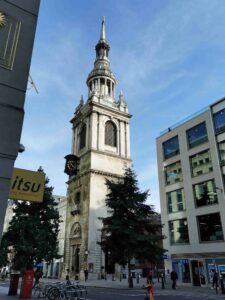
That’s the folk tale, but its inspiration – the real Richard Whittington – was hardly a rags-to-riches story. He was born in the early 1350s to wealthy Gloucestershire landowner Sir William Whittington and his wife, Joan, daughter of the Sherriff of Gloucestershire.
He Seeks His Fortune in London
Since the young Richard had two older brothers, he was not due to inherit any of his parents’ wealth, and so in 1379 he travelled to London to seek his fortune in trade as a mercer (a merchant). He became a member of The Mercers Company and dealt in valuable imports, luxury fabrics such as silks and velvets, much of which he sold to royalty and nobility from about 1388. From 1392 to 1394 he sold goods to King Richard II worth £3,500 – equivalent to £3,200,000 today!
In 1384 Whittington became a Councilman of the City of London. By 1393, he had become an Alderman and was appointed Sheriff of the City of London. He was also gaining a reputation as a man of good standing and influence, trusted by the king.
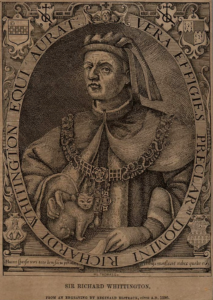
In 1388 he began moneylending, preferring this to outward shows of wealth such as buying property, and by 1397 he was lending large sums of money to the king. In June that year, the incumbent Mayor died while in office, and within two days the King had taken the unprecedented step of installing Whittington as his replacement.
One of Whittington’s first acts as Mayor was to negotiate the return of City lands which had been confiscated by the King five years earlier. He also personally oversaw the keeping of law and order in the city. So, if the populace had been wary of his sudden rise to power – they were happy enough to see him formally re-elected in October 1397.
By 1400 Whittington had acquired immense wealth and commercial prestige. He was elected Lord Mayor again in 1406 and 1419, making him Lord Mayor of London four times and surpassing the legend. In 1416 he became a Member of Parliament for the City of London. His popularity at court continued in the reigns of Henry lV and Henry V particularly in his role as money lender, thus expanding his vast wealth and his trustworthy reputation.
Twice Laid to Rest
On his death in 1423 he was buried in the church near his home in the city whose rebuilding he had financed – St Michael Paternoster Royal – alongside his wife Alice who had predeceased him. A plaque marking where he lived can be found near the church.
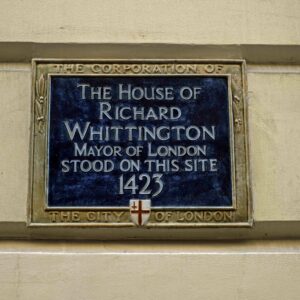
He was however, ignominiously dug up in the reign of Edward Vl on the orders of a greedy parson who mistakenly believed that great riches had been buried with him. Reburied, the tomb was ultimately destroyed in the Great Fire of London.
The Gifts
Having no children and never having remarried after the death of Alice, Whittington donated much of his profits to the city during his lifetime and left further endowments through his will.
Projects he financed in his lifetime included: the rebuilding of the Guildhall, a ward for unmarried mothers at St Thomas’ Hospital (‘yong wemen that hadde done a-mysse’), drainage systems for areas around Billingsgate and Cripplegate, the rebuilding of his parish church, St Michael Paternoster Royal, and a public toilet with 128 seats known as Whittington’s Longhouse in the parish of St Martin Vintry that was flushed by the River Thames at high tide.
He also created a charity in his will and entrusted The Mercers Company to administer it. Bequests included: the rebuilding of Newgate Prison, building the first library in Guildhall, repair of St Bartholomew’s Hospital, provision for an almshouse and college of secular priests attached to St Michael Paternoster Royal, and installing some of the first public drinking fountains. This bequest was the start of the livery companies’ long association with charitable aims and The Mercers Company is still corporate trustee to the Richard Whittington charity that provides almshouses to the elderly in Surrey and London.
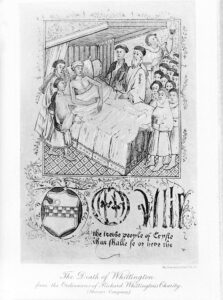
That Darned Cat
There is no evidence that Richard Whittington owned a feline, although cats often featured in portraits of the wealthy, as they were a popular symbol of good fortune. A cat is also a type of vessel for transporting coal which Whittington may well have owned. The City of London happily embraces the legend as can be seen in the Whittington window at St Michael Paternoster Royal, as well as the Mayoral window in Guildhall.
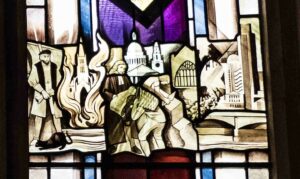
It was Richard Whittington’s generous gifts to the City that made him famous. Within just a few years of his death, the foundations of the Whittington legend were already being laid. He became a character in an English folk story which went on to become a play in 1604, which in the 19th century became popular as the pantomime we know today: Dick Whittington and His Cat.
Richard Whittington – with or without his cat – will forever be remembered as one of the great supporters of the City of London and one of the great merchant princes of medieval England.
Come on our Vikings, Whittingon and Wine walk to hear more about Richard Whittington.
